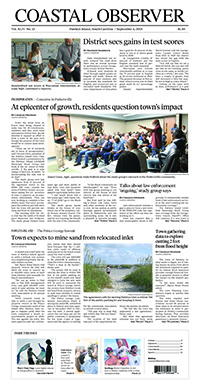Pawleys Island
Tree rules spark another push from board for permitting change

As the Pawleys Island Planning Commission starts work on rules to protect trees, members are questioning why Town Council hasn’t acted on its recommendations to take over building permits and inspections from Georgetown County.
Work on tree protection follows the adoption last year of architectural guidelines for new homes on the island. The guidelines were created to preserve the “Pawleys look” of cottage-style homes and slow the trend toward “boxy” structures.
Commission members are concerned about trees being cut to make room for new houses, and David Graham, an architect who worked with the commission to create the design guidelines, urged them to adopt landscape requirements as the next step in the process.
The commission last week reviewed the requirements from several coastal towns. Some require permits to cut a tree with a trunk diameter as small as 4 inches, and most require some form of mitigation or replanting when a tree is cut.
“If we could get something reasonable,” said John Hildreth, who chairs the commission. He would like to present tree protection measures to the council. “Once it’s cut, it’s gone.”
Hildreth favored a 5-inch minimum diameter for protected trees.
Because space is at a premium on Pawleys Island, combining tree protection with landscaping would make sense, said Carol Coleman, planning director for Waccamaw Regional Council of Governments, who is helping the town.
Requiring people who submit plans for new houses to submit a site plan that shows the existing trees on the site would be a good place to start, she said.
“I think we have a lot of education to do,” commission member Mark Hawn said. “I think most people want to do the right thing, but they don’t know what the right thing is.”
He offered to draft some options for the commission to recommend to Town Council, but said he wasn’t sure the council would act on them.
“I think we’ve got some convincing to do,” he said.
Commission member Robert Moser pointed out that the town’s last effort to adopt tree protection measures, in 1997, didn’t get approved. The town instead agreed to identify and mark trees in public spaces. “That’s sort of gone by the wayside,” he said.
Moser agreed that adding a site plan requirement to the architectural review was a good place to start.
“I think it’s great in theory,” Administrator Ryan Fabbri said, but added that enforcement will be the problem.
The town now contracts with Georgetown County to administer its building permits and inspections. Fabbri proposed in 2018 that the town take that back and hire a private firm to do the work. The commission endorsed the idea, but council never acted on the recommendation.
The commission raised the issue again in 2020 as it was working on the architectural review guidelines. The council was split over the idea, with Guerry Green and Rocky Holliday saying it would expand the town’s bureaucracy and give a private business an incentive to pursue work being done without a permit in order to collect a fee.
The commission voted again last fall to recommend the town contract with a private firm for building services. The council has not taken up the matter.
“We’ve been talking about this for years and can’t get it done,” commission member Ed Fox said. The concept pitched by the firm, CC&I Services, “sounded really promising. It just died.”
Fabbri first raised the issue because the county was failing to enforce requirements in the town’s unified development ordinance that could impact its rating in the federal flood insurance program. It then became a concern as the town tried to ensure that its roof-pitch requirements were being enforced to maintain its architectural style.
Fabbri also pitched it to the council as a way to offset the cost of its services. Georgetown County gets 100 percent of the permit fees collected in the town. The private company would get 80 percent.
“Nothing would change. Instead of contracting with the county, we would be contracting with a private business,” Fabbri said, adding that the county also contracts with CC&I for inspections.
Moser said the council’s reluctance was like the decision to reduce the police department from five members to four. “They want it to be smaller,” he said.
“I love the idea of government staying small, but when something hasn’t worked for years, it’s time to change,” Fox said.
The commission agreed to talk with the council members again.
“It will be an uphill battle, probably,” Hildreth said.




